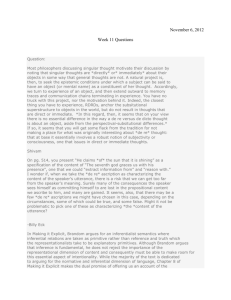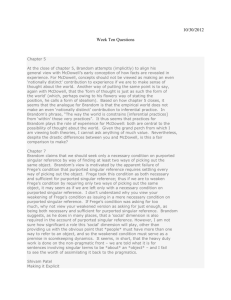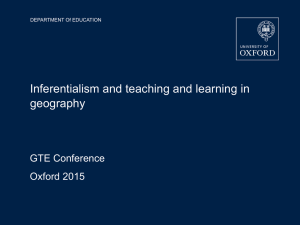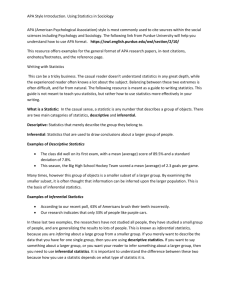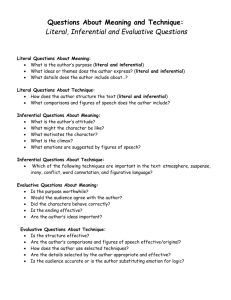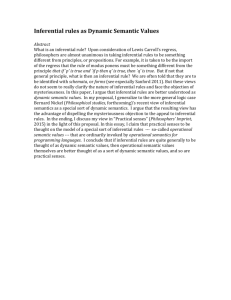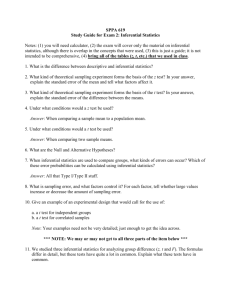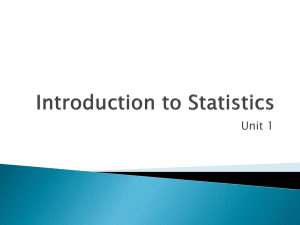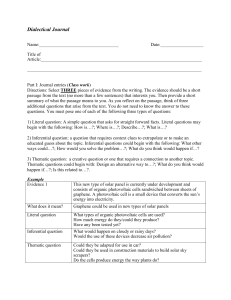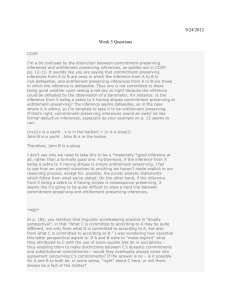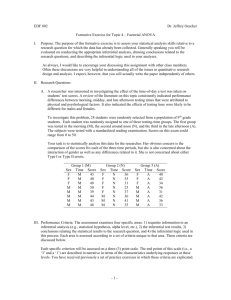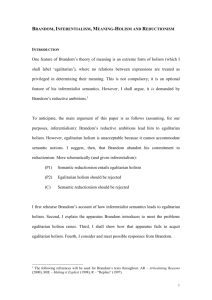Week four questions
advertisement
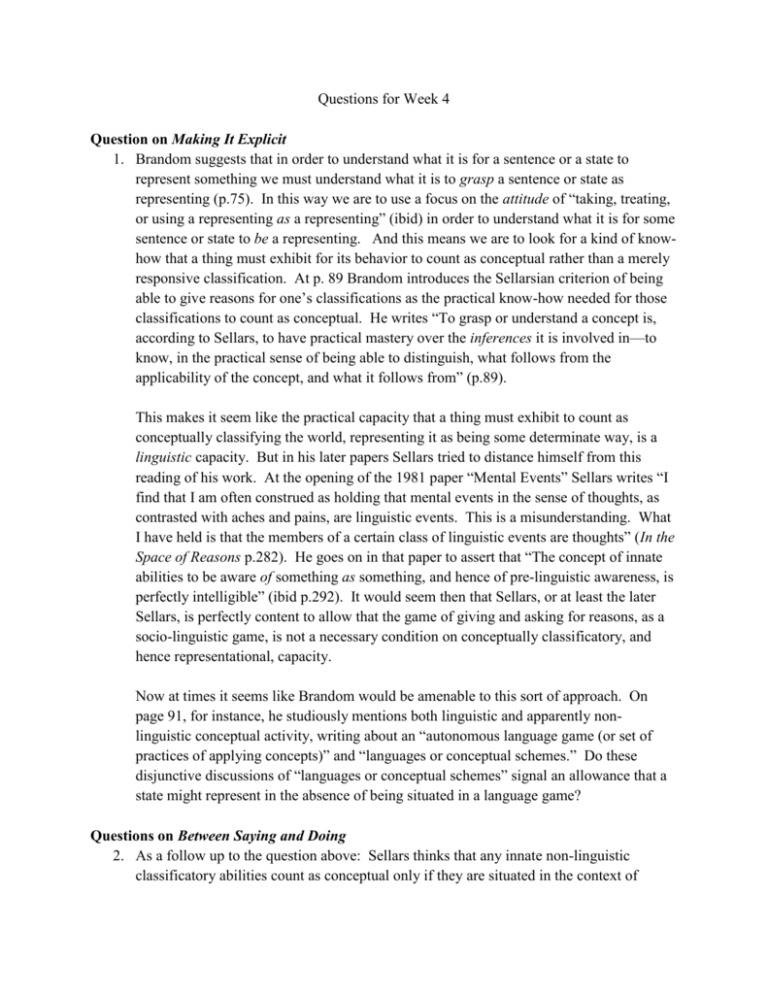
Questions for Week 4 Question on Making It Explicit 1. Brandom suggests that in order to understand what it is for a sentence or a state to represent something we must understand what it is to grasp a sentence or state as representing (p.75). In this way we are to use a focus on the attitude of “taking, treating, or using a representing as a representing” (ibid) in order to understand what it is for some sentence or state to be a representing. And this means we are to look for a kind of knowhow that a thing must exhibit for its behavior to count as conceptual rather than a merely responsive classification. At p. 89 Brandom introduces the Sellarsian criterion of being able to give reasons for one’s classifications as the practical know-how needed for those classifications to count as conceptual. He writes “To grasp or understand a concept is, according to Sellars, to have practical mastery over the inferences it is involved in—to know, in the practical sense of being able to distinguish, what follows from the applicability of the concept, and what it follows from” (p.89). This makes it seem like the practical capacity that a thing must exhibit to count as conceptually classifying the world, representing it as being some determinate way, is a linguistic capacity. But in his later papers Sellars tried to distance himself from this reading of his work. At the opening of the 1981 paper “Mental Events” Sellars writes “I find that I am often construed as holding that mental events in the sense of thoughts, as contrasted with aches and pains, are linguistic events. This is a misunderstanding. What I have held is that the members of a certain class of linguistic events are thoughts” (In the Space of Reasons p.282). He goes on in that paper to assert that “The concept of innate abilities to be aware of something as something, and hence of pre-linguistic awareness, is perfectly intelligible” (ibid p.292). It would seem then that Sellars, or at least the later Sellars, is perfectly content to allow that the game of giving and asking for reasons, as a socio-linguistic game, is not a necessary condition on conceptually classificatory, and hence representational, capacity. Now at times it seems like Brandom would be amenable to this sort of approach. On page 91, for instance, he studiously mentions both linguistic and apparently nonlinguistic conceptual activity, writing about an “autonomous language game (or set of practices of applying concepts)” and “languages or conceptual schemes.” Do these disjunctive discussions of “languages or conceptual schemes” signal an allowance that a state might represent in the absence of being situated in a language game? Questions on Between Saying and Doing 2. As a follow up to the question above: Sellars thinks that any innate non-linguistic classificatory abilities count as conceptual only if they are situated in the context of “other representational states and actions,” where “[p]rimitive inferences would also be involved.” These will include, for Sellars, prelinguistic analogues to language-entry transitions or perceptual takings (lo, smoke!), language-language transitions or inferrings (where there is smoke, there is fire), and language exit transitions or volitions (I shall get out of here now). And so it seems that what is needed is that a thing’s behavior be situated in a system of what Brandom calls reliable differential responsive dispositions (RDRD’s). I find Brandom’s discussion of RDRD’s in Making it Explicit difficult to pin down. In chapter 1 he argues against a reduction of language-use to reliable differential response, but in chapter 2 he remarks that the know-how involved in language-use will involve RDRD’s (p.88), and that indeed these RDRD’s will contribute to the content of linguistic episodes (p.119). RDRD’s appear also in Between Saying and Doing, and here they are characterized in normative terminology (p.34). Given that the problem with the regularist’s appeal to RDRD’s as a reduction of language-use (in MiE) was that such an appeal elided the distinction between proper and improper response, might this normative construal of RDRD’s afford a bridge from non-linguistic conceptual activity to its linguistic variety? At any rate, this prospect is not followed up on, as section 3 of chapter 2 shifts discussion to autonomous discursive practices, and section 4 reintroduces RDRD’s in the context of explicitly linguistic practices. But perhaps non-linguistic RDRD’s, situated in the kind of perception/inference/action context that Sellars and Brandom both think are necessary for explicitly conceptual activity, stand to language-entry/language-language/language-exit transitions as nonindexical vocabulary stands to indexical vocabulary (as argued in the appendix to BSD chapter 2). That is, just as anything capable of using non-indexical vocabulary is already doing enough to count as being capable of using indexical vocabulary, without this sufficiency relation counting as a reduction of the latter to the former, perhaps anything capable of properly situated RDRD’s is already doing enough to count as being capable of using a language. (This would be an in-principle capability in the sense discussed on p.38—it is not that a dog, say, whose RDRD’s count it as classifying some things as bobcats and other things as housecats can actually be made to speak a language, but that the abilities necessary for this differential classification are themselves analogues to language-transitions.) My suspicion is that evolved purposive dispositions, selected for and reinforced over evolutionary and educational processes, are just such RDRD’s that are PV necessary for employing any vocabulary. Preston Stovall MIE Ch2 The identification of conceptual content with inferential relations seems satisfy the theoretical role Brandom attributes to content (as determining the significance of a claim in a context or what we are committed to and to what we are entitled). However, is this the only role we ask of content? Intuitively it seems as though content should tell us what a claim is about. Brandom's account of content appears to face two important obstacles in satisfying this criterion. First, it seems to be unable to distinguish between coextensive terms. The sentence "Hesperus is visible" has the same content as "Phosphorous is visible" on Brandom's model since the two sentences include the same inferential relations. Second, it is unclear as to how content, in this sense, relates to the physical world. Conceptual contents function as a consistent and internally coherent set of beliefs but how are these beliefs about the world? How does Brandom escape McDowell's charge of "frictionless spinning in a void"? BSD Ch2 Brandom argues that it is only in virtue of conditionals that we are able to say something, as opposed to only doing something. This claim seems to rely on his model of propositional content as material inferential relations. However, I am unclear as to how to understand the former claim while also accepting the latter claim. Conditionals, it seems, must be primitive since our grasping a proposition not only requires but consists in (according to 2) that we are committed to certain other propositions which follow from the original proposition as well as propositions from which it follows. Given this model it seems as though grasping the proposition "the chair is red" consists in the conditionals, "if the chair is red, then the chair is colored" and "if the chair is red, then the chair is not blue". Although these conditionals are true and contribute to the meaning of "the chair is red", it seems as though we must have an independent understanding of "the chair is red" to get the project off the ground. Laura Davis *MIE *Ch. 2 Many of the examples of material inference in this chapter seem to be capable of being understood in purely formal terms, such as “Pittsburgh is to the West of Philadelphia” licensing the inference to “Philadelphia is to the East of Pittsburgh.” Examples like this exhibit a *monotonic*character, which makes it possible to understand them in formal terms. There is at least a plausible reading of the early Wittgenstein on color exclusion on which he seems to take this sort of route, due to his affirmation of the independence of atomic sentences It seems like you have inferences that would be very difficult to understand in this way in mind, like one from “This is a zebra” to “This has stripes” – inferences that can be defeated upon addition of further premises, such as “This is albino.” Is this correct? How does this change things? William Eck MIE 2 -On page 94 you say that the "still-dominant tradition ... reads inferential correctnesses off from representational correctnesses, which are assumed to be antecedently intelligible." You characterize the inferentialist approach as one "start[ing] with a notion of content as a matter of what is a reason for what and understand truth and representation as features of ideas that are not only manifested in, but conferred by their role in reasoning." Could asking the question 'How one makes a representation' make for an alternative approach? In representing something, it seems to me implicit that in selecting something 'as to be represented' is to necessarily presuppose a counter-concept that it is not otherwise. For example, one cannot utter the word 'red' to represent /that/ color unless one has inferred that there is something else to be 'not red'. This would support the referred to need of not having one concept but many concepts, in that how a concept is even formed requires 'two' (to single out one from otherwise). How does the 'still-dominant tradition' defend itself on that mark? Does it? BSD 2 -In relation to the above, on page 47 you say "that just as every autonomous discursive practice must involve distinguishing some inferences as materially good, so it must involve distinguishing some claims as materially /incompatible/ with others. That a monochromatic patch is red rules out its being blue. Only algorithmic elaboration is required to turn distinguish material incompatibility of claims into the ability to deploy logical /negation/. And once that bit of logical vocabulary is deployed, it (together with the conditional) lets one /say that/ two claimables are materially incompatible: 'If a monochromatic patch is red, then it is not blue.'" Would you agree that this distinguishing material incompatibility is necessary before one can say anything at all -- even to just say 'red'? Jacquet Kehm I had the following short question about Articulating Reasons Chapter One. Around page fifty-five you say that we can think of form in terms of a privileged vocabulary constant across substitutions of nonprivileged vocabulary. Accordingly, there might not only be logical form, but say, theological or aesthetic form, if we were to privelege those vocabularies. What would a theologically or aesthetically valid argument form look like? (I think it would be useful to see a couple of examples.) Sam Gavin 1. According to Brandom, in order for us to understand Sam’s utterance “This apple is red” as meaning this apple is red, we must attribute appropriate commitments and entitlements to Sam. If we merely attribute to Sam the commitment that the sky is blue and the entitlement that the sky is colored, we would not have understood Sam. Therefore which commitments and entitlements are appropriate to attribute must, for Brandom, be determined by an inferential semantics (how else is one to know which commitments and entitlements are appropriate?). This might be one important way in which Brandom’s semantics shed light on his pragmatics. However, suppose we meet Mrs. Malaprop armed with our inferentially backed attributions. She produces only those utterances for which our inferential semantics determine inappropriate commitments and entitlements, but despite this we understand her utterances perfectly well. She says “You’re taking me for granite”, the commitments and entitlements we would have ascribed would concern granite, but we know better. We know she means you’re taking me for granted. Brandom’s theory, assuming it describes how we interpret others, gives the wrong answers in cases of deviant speech. The point about interpreting deviant speech suggests, I think, that even in cases of interpreting *non-deviant* speech Brandom’s theory does not suffice, and perhaps might not even be necessary. The only bits of ‘theory’ left to ground interpretation would then be ones already made explicit by hearers themselves, e.g., “we have been friends for quiet some time now, so I know what you mean”. 2. The problem of the unity of the proposition consists in giving an account of how semantic primitives can be put together in such a way as to instance the unity of something that can be true or false. By claiming that propositional contents are primitive, however, Brandom seems to dismiss the problem of the unity of the proposition as a pseudo-problem, along with the framework of thinking about language that made it seem like a problem. But, in dismissing the problem of the unity of the proposition Brandom seems to introduce another problem into his fold. In particular, Brandom may not be able to account for how a subject can know the meaning of a potentially infinite number of sentences on the basis of finite means. Since it seems that the account of compositionality would, in many respects, mirror an account of the unity of the proposition, Brandom may also reject compositionality as a pseudo-problem. However, unlike the problem of the unity of the proposition, it seems that compositionality *does* present a problem. What is your attitude toward compositionality in the context of an inferential semantics? Shivam Patel Concerning chapter 2 of Making it Explicit, I want to address an issue related to the Dummettian notions of appropriate circumstances and consequences of the application of concepts introduced in section V (MiE, pp. 116 ff.). My question arises in the context of the elaborations about this Dummettian model in connection with the twin-earth thought experiment (cf. MiE, pp. 119/120); and maybe the difficulties I am having are only due to a misunderstanding about the specifics of this thought-experiment. Anyway, in the case of this twin-earth model, we can see that the application of the concept water to the substance XYZ is inappropriate from the perspective of the interpreter who considers the linguistic practices of the practitioners from outside their practices. Within the language-game of the earthlings (and the twin-earthlings), however, the concept application might be considered as appropriate. After all, it is possible that the earthlings do not and cannot possibly know that there is a difference between water and twater in terms of their chemical composition. Now, should we regard their concept application as inappropriate if judged by their internal standards of appropriateness, that is, if judged by what they know and could possibly know as appropriate circumstances of the application of some concept? Apparently, this question concerns the relevant perspective and the context of any assessment of the appropriateness of a concept application: we may admit that the practitioners in the twin-earth model are not „omniscient about the inferential commitments implicit in their own concepts“ (MiE, p. 119) –– this is, more or less, a consequence from the ideal set-up of the thought experiment. And I am inclined to say here: they are not omniscient about all their inferential commitments. But they surely know some of the inferential commitments implicit in their concepts; and isn‘t that knowledge enough to account for the appropriateness of their concept application? Who is to decide which circumstances should enter the determination of the appropriateness of a concept application, that is, what inferential commitments have to be (made) explicit in order to decide whether a concept application is appropriate? In other words: in what sense is omniscience required here to decide whether a concept application is appropriate? And in what sense could we say that the interpreter (in the twin-earth model) is omniscient? Since we cannot rely on such an ideal interpreter if we try to examine the appropriate circumstances of our own concept applications in real life, I was wondering whether we should understand the appropriateness of a concept application as involving all possible circumstances that could render a concept application as appropriate or inappropriate? Does it involve all possible circumstances which an imagined, ideal interpreter could be acquainted with and be omniscient about in order to assess whether our concept applications are appropriate? Florian Rieger My question is, in effect, what the reasons are for making anything explicit and, hence, for developing and using logical (normative, semantic, intentional...) vocabulary at all. Of course, at one level, there is a straightforward enough answer: we want implicitly relied-on material inferences (as well as patterns of language-entry and exit) to become the subject matter of explicit discussion. However, when thinking about the purpose of _that_, I can think of two good answers, and I have a feeling that (at least) MIE takes only one of them seriously. The first one, which appears on numerous pages in MIE, is that once an inferential or non-inferential pattern is made explicit, we can assess our entitlement to it, individually or in an open exchange of multiple speakers. Here is a clear formulation: »In Reason's fight against thought debased by prejudice and propaganda, the first rule is that material inferential commitments that are potentially controversial should be made explicit as claims, exposing them both as vulnerable to reasoned challenge and as in need of reasoned defense« (126). A few pages later, there is also explicit mention of »discovering and repairing discordant concepts« (130, my emphasis). The second one is this. We make the internal relations (inferential and non-inferential links) which constitute our individual idiolects explicit by way of logical (normative, semantic,...) vocabulary in order to help other speakers translate our idiolects into theirs. This, of course, is a prerequisite for any judgments about whether a particular communicative problem between individual speakers amounts to a disagreement or merely an instance of (complex, formerly undetected) talking past one another. It is also a prerequisite for the possibilty of _adopting_ another speaker's idiolect. This way of looking at logical (normative, semantic,...) vocabulary suggests that its use is one of the _calibration_ of different speakers' linguistic dispositions against one another. Both sets of reasons are compatible with the slogan that »logic is the organ of semantic self-consciousness« (9). I wonder if there is any systematic reason for the emphasis on the first, or rather the silence on the latter set of reasons. May not the second set of reasons even be the more fundamental one? Matthias Kiesselbach *BSD,* Ch. 2 Last week, in your response to my question (concerning how one is better off with regard to the gerrymandering problem if one employs deontic modality rather than alethic modality), you described part the aim of making practices explicit, in deontic rules, in the act of interpretation as saying *what you have to take *someone to be doing in order to take them to be engaging in certain practices, or employing certain vocabularies. I wonder what this means for our understanding of PP-Necessity: Granted that everything in *MIE *is true, is to say that Practice A is PP-Necessary for Practice B just to say that *in order to take someone as engaging in*Practice B, *we must take them to be also engaging in *Practice B? If so – how limited is the domain of “we” – the set of discursive beings, the set of human beings, the set of members of a given culture? In *BSD *PP-Necessity sounds like a much stronger relationship, and I wonder if this is simply because the *BSD *framework is meant to be applicable to a broad range of theories, or because there is in fact a stronger relationship than the one I am currently attributing to you. William Eck *BS2**, Ch. 2*: On p.43, you claim that *inferential *practices are “PV-necessary for the for the deployment of every vocabulary whatsoever” because they “are PP-necessary components of every autonomous discursive practice.” In this question, I’m interested in how to justify or motivate the latter claim—i.e., that any ADP presupposes inferential practices. It seems to me that you take this claim for granted as a starting point for your analysis, and suggest that a reader could look to *MIE* for arguments for it. But a reader who wants to read *BSD *in isolation from *MIE* might find that taking this as a starting point begs the question concerning your later argument for “semantic logicism”. I’ll try to motivate her worry. In 2:5, you explain that semantic logicism, which gives logical vocabulary a “special role” in “the process of elaborating one vocabulary into another” (49), got something right. You then argue for this by showing that both horns of the logicist dilemma can be avoided by appealing to the fact that logical vocabulary can be both *elaborated* from and *explicative*of any ADP (“LX” relation), as any ADP presupposes inferential practices. That’s what seems to beg the question: Ultimately the “LX”-relation that justifies the special role of logic in semantic analysis rests on the assumption that inferential practices are PP-necessary for any ADP. Let’s quickly run through why this, though restricting ourselves to conditionals for simplicity: It is because inferential practices are taken to be PP-necessary for deploying any ADP that one can begin with “the ability to respond differentially to moves relating one set of…sentence-tokenings to another as *inferences* [a] system [that can deploy any vocabulary] is disposed to *endorse*” as primitive ability that can be algorithmically elaborated into further abilities (44). This ability to distinguish good and bad inferences is then shown to be to be “(PP-)*sufficient* for the ability to deploy conditionals involving [non-logical] sentences” (45). Conditional vocabulary is then shown to have a “distinctive expressive role” of “mak[ing] *explicit* something that otherwise was *implicit* in the practical sorting of non-logical inferences into good and bad.” That is, after the algorithmic introduction of conditional vocabulary “one can endorse or reject [an] inference by *saying*something” (46). But, other starting points seem possible (though I’m not sure how one argue for most of them). Let’s look at example. Perhaps someone’s semantic theory starts with the idea that all ADPs presuppose treating each other as meaning things by saying things, so intentional vocabulary (like the word ‘means’ in “He *means* *p* by saying *p*”) can be algorithmically elaborated from any ADP, and bear an “LX”-relation to the original practices-and-abilities. [I take it that this suggestion is somewhat like Shivam Patel’s from last week]. In that case, intentional vocabulary might be thought to play the “special role” that you, agreeing with the bulk of 20 th century analytic philosophy, give to logic alone. I wonder if we might then reverse the order of motivations, so to speak, so that *BSD* can be taken to give a theoretical argument for why we should take inferential practices to be PP-necessary for any ADP. The idea here is to begin with the assumption that logic really does have the special role that “semantic logicism” says it does. Then, we could say that logical vocabulary—in order to unlock the logicist’s dilemma with a pragmatic key—must bear an “LX”-relation to the practices-or-abilities PP-necessary for deploying an ADP. This then shows that inferential practices must be PP-necessary for any ADP. It’s true that this starting point might also be thought of as question begging (consider: the later Wittgenstein’s work or Derrida’s “logocentrism” complaint), but it seems to me that this strategy gives an interesting motivation to your projects in general. What do you think of this suggestion? *MIE**, Ch.2*: I’m not sure if this a small question or a large one, so I figure it’s particularly worth asking, if for nothing else, for the sake of clarification. In 2:I:3, you discuss representational purport, and explain that an account of representational content requires an account of representational purport, that makes room for purport to be “veridical or spurious” (73). You then go on to say that this requires us to give an account of the “uptake, grasp, of understanding of such purport” (74), since, as Dennett says, representation is always “to or for someone”. I’m still a little unclear about how the move from whether the purport can be veridical or not to needing an account of understanding purport, though it feels more-or-less right to me. I suppose someone could say that what it means for a purport to be veridical is for it to be objective, *viz*., stand in some relationship to objects that holds independently of how anyone understand the purport. Is there something incoherent about this response? Seeing that there is might be helpful in understanding why to go for an inferntialist as opposed to a representational semantics. Chuck Goldhaber
